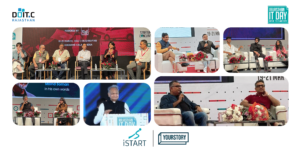For brands, there has never been a better time to leverage digital advertising. Riding on the power of enhanced storytelling and precision targeting, digital ad campaigns are reaching millions of audiences. For instance, Foodpanda’s ad hit more than five million views on OTT platforms and British Airways’ famous “Fueled by Love” has been viewed more than 10 million times on YouTube.
Forecast data indicates that the ad spending worldwide will reach $691 billion by the end of 2023. These figures underline the need for optimising the marketing approach by brands to reach relevant audiences. And with advanced technology, it is easier than ever to gain insights about changing user behaviour and harness those insights to achieve maximum impact.
Coup d’œil: Adtech replacing traditional ads
In these times of uncertainty, with remote working modules stretching further than expected and corporations opting for a hybrid home-office model, most organisations are leaning on their digital strategies for effective marketing. In fact, companies that ignore these changes today are missing out on several significant opportunities to grow.
Blockbuster, a former provider of movies and video games on rent, employed 84,000 people worldwide. Quantity and variety were its biggest powers, making the company stand apart from other rental stores. However, when Netflix came with on-demand streaming services, Blockbuster didn’t realise the need for going digital, which ultimately led to its downfall.
In this context, the era of years-long advertising campaigns has become history, and digital ads have turned bite-sized, instantly, flashing across TVs, laptops, desktops, and mobile screens.
In fact, in a year when total ad spends plummeted by 17 percent, investments in digital ads snowballed by 15 percent, clearly demarcating the direction traditional and digital advertising are taking.
A recent report by Dentsu predicts that digital ad budgets will touch the level of TV by the end of 2022, a watershed moment that without pandemic would have happened only by 2025. Undoubtedly, adtech has matchless potential. It is already directly impacting the way the audience interacts with sponsored content.
Given the rapidly changing online user behaviour, adtech will continue to dictate how content is marketed online.
Earlier, TV viewers dominated the market, but the OTT sector has now witnessed a 30 percent increase in the number of paid subscribers.
No advertiser would like to spend on media channels with no audience or revenue potential, so as consumer behaviour evolves, advertising budgets will follow the direction.
Factors driving the growth of adtech
1. The increasing role of AI
Artificial intelligence (AI) is taking the ad world by storm. In the adtech industry, AI helps analyse trends to gain more granular insights and better target your customer base. This also improves cost savings, thus increasing the ROI and boosting user productivity.
Integrating AI into digital ad marketing, brands can make themselves more relevant with respect to time, location, brand narrative and vision, thereby elevating consumer engagement.
2. The advent of video personalisation
The global video advertising segment is projected to grow at a CAGR of 10.17 percent between 2021 and 2026. Of this, 85 percent will be on mobile phones alone. This indicates that though video ads dominate the market, focusing on mobile videos will help brands increase client traction, sales volume and overall growth. Innovations in software sectors stimulate video personalisation.
In fact, a surge in consumer demands for video-ad content is now apparent, and web-based media platforms, including websites and online portals, are rapidly adapting to this change.
3. Programmatic advertising continues to reign supreme
Owing to exponentially increasing usage of latest softwares and algorithms, brands can now streamline and automate the ad buying process. In fact, this has made programmatic advertising an indispensable marketing tool of the contemporary market.
As per a Statista report, the global programmatic ad spend was valued at $129 billion in 2020 and is projected to reach $155 billion by the end of this year.
4. 3D Impact Creatives and VR
Considering most industries are focused on offering virtual tours instead of physical exploration opportunities to consumers, 3D Impact Creatives and Virtual Reality (VR) technology are playing an instrumental role in promoting brands.
For instance, 3D Impact Creatives equip consumers with full-stack control, allowing them to get a zoomable view of the product with a simple touch or scroll. These technologies offer more productivity in limited ad space, cutting expenditure drastically.
Coupled with precise analytics and online targeting, it generates optimum traction and ROI. Industry giants like Samsung and TATA Motors are all leveraging the full potential of this lucrative technology.
5. Moving towards a cookieless future
Data privacy has remained a significant concern for internet users across the globe. 40 percent of users believe that companies don’t use their data ethically, as highlighted by KPMG research.
As a result, leading internet browsers like Safari and Firefox have disabled third-party cookies, while Google Chrome is planning for the same by 2023. For marketers and advertisers, this might seem to be an end. But it’s not! They must take it as a fresh opportunity to reshape their consumer targeting strategies by shifting their focus from third-party data to first-party data.
By leveraging this approach, brands can do on-demand consumer research and target their budget to serve consumers that matter most rather than take the guesswork route. With suitable marketing approaches, cookieless advertising can be a blessing for advertisers as much as it is for consumers.
In a nutshell
Data shows that cutting-edge technologies will drive the future of advertising with enhanced customer engagement and precision targeting.
A recent report highlights that 59.5 percent of the global population is actively using the internet today. Of this, 92.6 percent users access the internet through smartphones. These users are no longer satisfied with standard storytelling. Instead, innovative videos with an engaging narrative, augmented reality, virtual technology, and personalised elements attract traction, thereby yielding high returns for the ad investment.
On the back of fast-growing adtech solutions, traditional Indian advertising is revamping itself for a digitally advanced outlook. According to a Statista report, the Indian digital ad market was valued at Rs 47 billion in FY 2015, soaring to Rs 199 billion in 2020. It is expected to skyrocket to approximately Rs 539 billion in 2024, indicating that adtech’s ripple effect yields productive returns.
Therefore, companies must embrace digital ad norms to build a competitive advantage and thrive in a highly volatile business environment.
(Disclaimer: The views and opinions expressed in this article are those of the author and do not necessarily reflect the views of YourStory.)










![Read more about the article [App Friday] Bikayi’s tech is extremely suitable for mobile-first MSMEs trying to go digital](https://blog.digitalsevaa.com/wp-content/uploads/2022/05/Imagers7d-1653557514360-300x150.jpg)